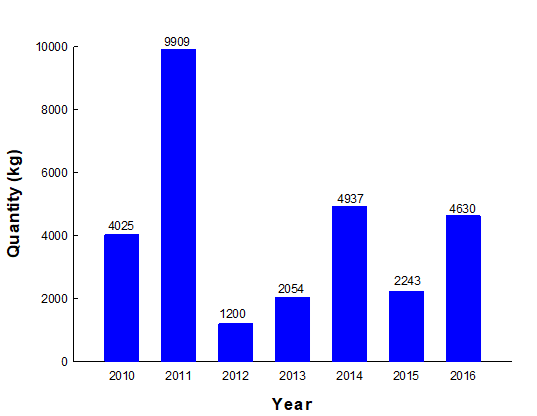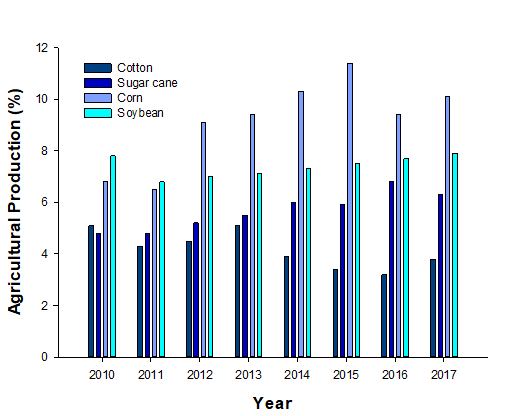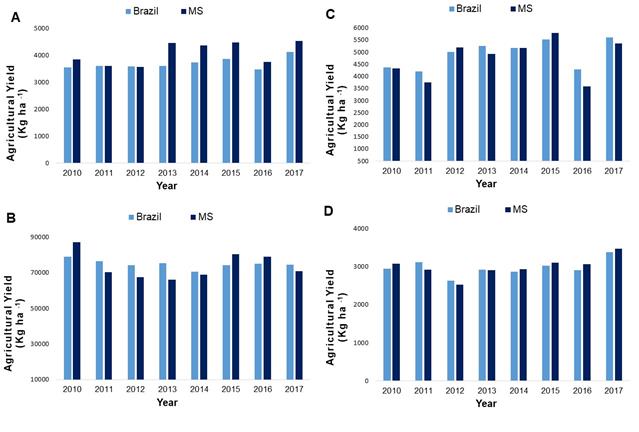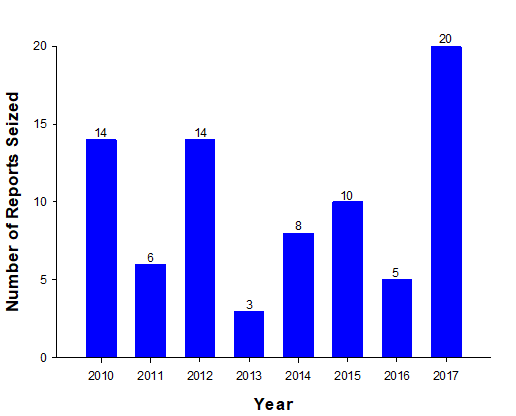INTRODUCTION
The use of agricultural pesticides still is essential to supply the market and ensure the world's food supply, since it’s use increases productivity and quality in food production (Passos and Reis, 2013). Starting in 1970, the Green Revolution has promoted the intensive use of agricultural pesticides with the aim of increasing agricultural productivity and solving the hunger problem around the globe. Despite this, other problems have arisen due to the indiscriminate use of these compounds, such as contamination of the environment and hazards to human health (Andrades and Ganimi, 2007).
The pesticides have several types of classification: according to the chemical structure, in relation to neurotoxicity, the effects it causes to human health and the action of its active principle in the target organism (Savoy, 2011). The most common way of classifying pesticides is in relation to the active principle, divided into the following types: insecticides (insect control), herbicides (control of invasive plants), fungicides (elimination of fungi), nematicides (combating nematodes), fumigants (control of bacteria in the soil), acaricides (elimination of mites), molluscicides (mollusc control), as well as growth regulators, desiccants and defoliants (control of interfering leaves). Among these compounds, the insecticides and herbicides are the most used classes (Terra, 2008). Some investigations (Schiesari, 2012) have emphasized the importance of knowing the active principles, taking into account that they are responsible for the toxic action of the compounds and that there are several formulations containing the same active principle but they can vary in concentrations and inert ingredients.
Regarding the situation in Brazil one of the major global players in agriculture, to maintain high as productivity levels, it is of agriculture pesticides, highly dependent on, which it is also the largest consumer in the world (Souza et al., 2009). Such huge commercial market had obviously attracted international companies that licitly commercialize such products, but it has also opened the possibilities for the so called pesticide smugglers. The precise amount of illegal products such as active principles or inert substances banned in the country is not so accurate in federal agencies like the Ministry of Agriculture, Cattle and Supplying (Ministério da Agricultura, Pecuária e Abastecimento, MAPA), the Ministry of Health and the Brazilian Institute of Environment and Renewable Natural Resources (Instituto Brasileiro do Meio Ambiente e dos Recursos Naturais Renováveis, IBAMA), as there is not a central management for the apprehension of such illegal compounds.
For the registration of pesticides, Brazilian law requires that they comply with the guidelines and requirements of the federal agencies responsible for the health, environment and agriculture sectors (Casa Civil, 1989). Thus, the often usage of such illegal products can be very dangerous and increases the risks to the environment, food safety and human health due to the lack of regulation of this products (Fraga, 2012).
In the Brazilian market, illegal insecticides are marketed with values five to ten times lower than legal products (Dorfman et al., 2014). Some Brazilian states such as Rio Grande do Sul, Paraná, Mato Grosso, Mato Grosso do Sul and Goiás have higher rates of pesticide smuggling because neighbor countries (e.g., Uruguay) do not require the agronomic prescription for the purchase of some pesticides, which facilitate their entry through Brazilian boundaries. The above mentioned Brazilian states have frequent records of illegal pesticide apprehensions (Dorfman et al., 2014). Between the years of 2012 and 2017, the State of Mato Grosso do Sul was among the four states with the highest number of reported illegal pesticides. Lemos et al. (2018) pointed out that, in this period, the active ingredients that were most identified in clandestine products were the insecticides imidacloprid, amamectin benzoate, fipronil and the herbicide metsulfuron-methyl.
In order to provide a better understanding of the commercialization of illegal pesticides in Brazil, we conducted surveys aiming to determine the profile of apprehended pesticides in the state of Mato Grosso do Sul, one of the most relevant agricultural frontiers in Brazil, during the period from 2010 to 2017 as well as the agricultural productivity and human poisoning in this period.
MATERIAL AND METHODS
Brazilian states with the largest number of illegal pesticide apprehensions. Official information on the number of apprehension for illegal pesticides in Brazil from 2010 to 2017 was provided by the System of Control of Seized Goods (Sistema de Controle de Mercadorias Apreendidas, CTMA). For this, the data request was made through the access to the Electronic System of the Citizen Information Service (Sistema Eletrônico do Serviço de Informação ao Cidadão, e-SIC), of the Ministry of Finance (Ministério da Fazenda).
The data provided by CTMA were grouped by fiscal regions (i.e., Regiões Ficais - RF) that refers to the geographical regions of Brazilian states. For instance, the RF1 comprehend the Brazilian states of Distrito Federal, Goiás, Mato Grosso, Mato Grosso do Sul e Tocantins; RF2 comprehend the Brazilian states of Acre, Amapá, Amazonas, Pará, Roraima e Rondônia; RF3 comprehend the Brazilian states of Ceará, Maranhão e Piauí; RF4 comprehend the Brazilian states of Alagoas, Paraíba, Pernambuco e Rio Grande do Norte; RF5 comprehend the Brazilian states of Bahia e Sergipe; RF6 comprehend the Brazilian states of Minas Gerais; RF7 comprehend the Brazilian states of Espírito Santo e Rio de Janeiro; RF8 comprehend the Brazilian state of São Paulo; RF9 comprehend the Brazilian states of Paraná and Santa Catarina, and RF10 comprehend the Brazilian state of Rio Grande do Sul.
The unofficial data was provided by the National Union of the Product Industry for Plant Protection (Sindicato Nacional da Indústria de Produtos para Defesa Vegetal, 2018).
Apprehension of illegal pesticides in the state of Mato Grosso do Sul. The information on the number of apprehension of illegal pesticides in the state of Mato Grosso do Sul 2010 to 2017 was provided by the Scientific Technical Sector of the Regional Superintendence of the Federal Police of Mato Grosso do Sul. For this, the data request was made through the access to the website of the Brazilian Federal Police and requesting reports on the profile of pesticides apprehended in the Mato Grosso do Sul state from 2010 to 2017. Data were collected from the reports of the Information System on Criminal Bases (Sistema de Informações em Bases Criminais, 2015). From the data, an identification of the substance, type of pesticide, origin and registration in Brazilian Health Regulatory Agency (Agência Nacional de Vigilância Sanitária, 2003) and MAPA were performed.
Data collection concerning human poisoning by toxic agent and circumstances. Data related to human intoxication in Brazil from 2010 to 2017 were provided by the Ministry of Health. For this, the data request was made through the access to the website of the National Toxic-Pharmacological Information System (Sistema Nacional de Informações Tóxico-farmacológicas, 2018), which is the currently agency responsible for the compilation of annual poisonings (independent of the toxic agent origin) in the Brazilian territory.
Agricultural Productivity in the state of Mato Grosso do Sul. Agricultural productivity data were provided by the Brazilian Institute of Geography and Statistics (Instituto Brasileiro de Geografia e Estatística, 2018). Data were collected from the Municipal Agricultural Production (Produção Agrícola Municipal, PAM) report. The agricultural production and the agricultural yield for the cotton, sugarcane, corn and soybean crops in the state in the state of Mato Grosso do Sul from 2010 to 2017 were evaluated.
RESULTS AND DISCUSSION
Illegal pesticide apprehension. According to federal agency CTMA, the RF9 was the only fiscal region that was among those that presented the highest number illegal pesticide apprehensions throughout the period analyzed. In addition to this region, others can be identified (Table 1).
Table 1 Fiscal regions in seizures of illegal agrochemicals.
| Year | Fiscal Regions | Corresponding States | Apprehension (%) | Other Regions (%) |
| 2010 | RF1; RF9; RF10 | DF; GO; MT; MS; TO; PR; SC; RS | 99.7% | 0.3% |
| 2011 | RF1; RF9; RF10 | DF; GO; MT; MS; TO; PR; SC; RS | 56% | 44% |
| 2012 | RF1; RF9; RF10 | DF; GO; MT; MS; TO; PR; SC; RS | 99% | 1% |
| 2013 | RF1; RF9; RF10 | DF; GO; MT; MS; TO; PR; SC; RS | 98% | 2% |
| 2014 | RF8; RF9; RF10 | SP; PR; SC; RS | 96% | 4% |
| 2015 | RF8; RF9; RF10 | SP; PR; SC; RS | 89% | 11% |
| 2016 | RF8; RF9; RF10 | SP; PR; SC; RS | 97% | 3% |
| 2017 | RF6; RF9; RF10 | MG; PR; SC; RS | 93% | 7% |
Source: CTMA, 2018. DF = Distrito Federal; GO = Goiás; MT = Mato Grosso; MS = Mato Grosso do Sul; TO = Tocantins; PR = Paraná; SC = Santa Catarina; RS = Rio Grande do Sul; SP = São Paulo; MG = Minas Gerais.
Apprehension of illegal pesticides in Mato Grosso do Sul. Data on illegal pesticide apprehension in Mato Grosso do Sul, according to non-official agency SINDIVEG are presented in the Figure 1.

Figure 1. Apprehension of illegal agricultural pesticides in the state of Mato Grosso do Sul (SINDIVEG, 2018).
According to the federal agency SISCRIM, the Federal Police of Mato Grosso do Sul reported, between 2010 and 2017, the apprehension of 80 products in allegedly illegal situations. Figure 2 shows the annual distribution of reports.
The most frequent active principles characterized among the illegal products apprehended in the state of Mato Grosso do Sul, from 2010 to 2017 are shown in Table 2.
Table 2 Most frequent active principles detected in apprehended illegal products.
| Active Principles per Year | |||
|---|---|---|---|
| 2010 | 2011 | 2012 | 2013 |
| Chlorimuron Ethyl Imidacloprid Acetamiprid Fipronil | Acetamiprid Carbofuran | Acetamiprid Imidacloprid Fipronil | Methylsulfuromethyl Fipronil |
| 2014 | 2015 | 2016 | 2017 |
| Acetamiprid Imidacloprid Methylsulfuromethyl | Acetamiprid Thiamethoxan Methylsulfuromethyl | Thiamethoxan | Acetamiprid Emamectin Benzoate Imidacloprid Thiamethoxan |
Human poisoning in Brazil
The SINITOX presented information on 19 types of toxic agents. Table 3 identifies some of these agents that contributed the most to human intoxication rates between 2010 and 2017.
Table 3. Registered cases of human intoxication by toxic agent (Sinitox, 2018).
| Agents | Cases Recorded per Year (%) | |||||||
|---|---|---|---|---|---|---|---|---|
| 2010 | 2011 | 2012 | 2013 | 2014 | 2015 | 2016 | 2017 | |
| Medicament | 26.81 | 28.51 | 27.32 | 28.04 | 29.82 | 31.55 | 34.04 | 25.18 |
| Household Cleaning Products | 10.82 | 10.60 | 7.94 | 8.26 | 11.50 | 9.97 | 9.62 | 5.04 |
| Scorpions | 10.68 | 10.09 | 11.52 | 10.66 | 10.97 | 11.55 | 13.95 | 36.04 |
| Other Animals Venomous | 5.62 | 5.10 | 4.60 | 4.91 | 4.23 | 6.78 | 1.82 | 2.55 |
| Drugs of Abuse | 6.54 | 6.17 | 7.64 | 6.62 | 3.76 | 4.01 | 3.58 | 2.54 |
| Agrochemicals for Agricultural Use | 5.35 | 4.78 | 4.63 | 4.46 | 3.78 | 3.66 | 3.57 | 3.97 |
| Industrial Chemicals | 5.33 | 5.75 | 5.06 | 5.94 | 4.96 | 4.39 | 4.69 | 2.65 |
| Others | 28.85 | 29.00 | 31.29 | 31.11 | 30.98 | 28.09 | 28.73 | 22.03 |
Agricultural production and productivity in the state of Mato Grosso do Sul. The agricultural products of the state of Mato Grosso do Sul that were part of the Municipal Agricultural Production (Produção Agrícola Municipal, PAM) report issued by IBGE (2018) were: Pineapple (Ananas comosus), cotton (Gossypium hirsutum), peanuts (Arachis hypogaea), rice (Oryza sativa), oats (Avena sativa), sugarcane (Saccharum officinarum), beans (Phaseolus vulgaris), sunflower (Helianthus annuus), cassava (Manihot esculenta), watermelon (Citrullus lanatus), soybeans (Glycine max), sorghum (Sorghum bicolor), tomatoes (Solanum lycopersicum), wheat (Triticum aestivum) and corn (Zea mays). The Figure 3 shows the agricultural production for the cotton, sugarcane, corn and soybean crops in the state during the period evaluated.

Figure 3. Agricultural production in the state of Mato Grosso do Sul. Data show the percentage of production in relation to the national production in the respective years.
The agricultural yields for the cotton, sugar cane, corn and soybean crops in the state of Mato Grosso do Sul and in Brazil are highlighted in Figures 4.

Figure 4. Average yield of national production and in the state of Mato Grosso do Sul for cotton (A), sugar cane (B), corn (C) and soybean (D) (IBGE, 2018 - Municipal Agricultural Production).
The RF1, RF9 and RF10 fical regions presented the highest number illegal pesticide apprehensions between the years of 2010 and 2013 (Table 1). Such regions comprise a large number of Brazilian states, including the state of Mato Grosso do Sul. The Mato Grosso do Sul state presented a high number of illegal pesticide apprehensions, especially in the year of 2011 (Figure 1). Although the SINDIVEG (2018) is not an official agency, it can provide relevant data, as they made possible to classify the apprehension results by Brazilian state. Furthermore, the data on annual reports in the State of Mato Grosso do Sul do not reflect the total amount of illegal pesticides seized (Figure 2). Thus, the data provided by the official agencies (i.e., Ministry of Finance) could not clearly describe the actual picture of seizures in a territory of single Brazilian state.
This position obtained by the Mato Grosso do Sul state in the rankings can be explained by the fact that this region is an agricultural and boundary frontier, which facilitates the entry of these illegal products by this region. Similar situation can be perceived in other agricultural and boundary frontier states (e.g., Paraná and Rio Grande do Sul), which is the most common pathway used to bring these illegal products to other states (e.g., São Paulo) where agriculture is also very relevant.
The most prevalent agronomic category in the apprehended pesticides was the synthetic insecticides, according to the most frequent active principles detected (Table 2). We can highlight the neonicotinoid insecticides imidacloprid, acetamiprid and thiamethoxam but also the fenylpyrazoles fipronil. Such assumption makes even more sense if we consider that these active principles are among the most used in the agricultural crops planted in the Mato Grosso do Sul state. Although these active principles being commonly found in legally products marketed in Brazil, the apprehended products were not authorized at that time by MAPA agency, which turn their importation, commercialization and use in Brazil as illegal actions.
Regarding the occurrence of human intoxication (Table 3), from the data analyzed from 2013 up to now, we can a false idea that there was a reduction in the number of intoxication by agrochemicals for agricultural use. In fact, the smaller numbers result from the low participation of the Information Centers and Toxicological Assistance (Centros de informação e Assistência Toxicológicas, CIATS) for registering such data (Azevedo, 2006). CIATS act to assist the intoxicated patient and provide information and guidance on diagnosis, prognosis, treatment and prevention of poisoning. Based on available data, intoxications were primarily caused by medications (i.e., pharmaceuticals). In relation to pesticides for agricultural use, there are few intoxication records and intoxication by food intake was less than 0.5% of the records. Despite data available for illegal pesticide seizures and occurrence of human intoxication, it is not possible to establish a correlation between such parameters, as statistical data are lacking to establish such correlations.
Interestingly, it can be said that the Brazilian Central-Midwestern regions, where the state of Mato Grosso do Sul is located, has more expressive records of food poisoning. Of the total national registries, approximately 54% of total of records in the entire country (for the years of 2010 to 2013) were reported in these region. When we took an extended period (i.e., from the year 2010 up to the year of 2016), there were 52 records of food poisoning in Brazil, which surely is an amount that is far distant of the reality. These records were certainly related only for the acute or immediate intoxication, not taking in consideration the potential intoxication derived of chronic (i.e., for longer time periods) exposures.
It is difficult to establish the relationship between food contamination and illegal pesticide apprehension, since the data provided by non-official agency SINITOX brings data referring only to the number of intoxications and does not bring data regarding the food type that potentially caused the intoxication. Recent investigation (Carneiro et al., 2015) have emphasized the need of studying the presence of pesticide residues in the diversity of food consumed by humans. The lack of data regarding this also turn such the potential correlation between human intoxication and the use of illegal pesticides an even more complex task.
As discussed above, from 2010 to 2013, Mato Grosso do Sul state was among the regions with the largest number of illegal pesticide apprehensions, according to CTMA and SINDVEG (2018) data (Table 1 and Figure 1). Within this period, it was possible to observe a lower agricultural productivity of the evaluated crops compared to the rest of the period analyzed, according to PAM report (Figure 3). In 2011, when it occupied the second place in seizures, about 71% of the crops presented yields below the national average. In 2012 it presented similar income to the previous year, which may be a reflection of the previous harvest. In 2013, when the fiscal region to which the state belongs ranked first in seizures, 59% of the crops presented agricultural yields lower than the national average. In 2015, about 71% of crops presented yields below the national average and the state ranked third in the number of pesticides apprehended. On the other hand, in the years 2016 and 2017, more than half of their crops showed yields above the national productivity average, and it was also verified that both official and unofficial data pointed to a reduction in apprehension of illegal products. It is possible to infer a relation in the reduction of the apprehension, which may be due to the reduction of the entry of illegal products in the state, thus contributing to an increase in crop productivity. Fraga (2012) corroborates with the understanding that the use of illegal products interfered with their effectiveness to keep the higher agricultural productions, which may be due to the low reliability of the chemical composition.
CONCLUSIONS
From 2010 to 2013, the state of Mato Grosso do Sul was among the regions in Brazil that had the largest number of seizures of illegal pesticides. Additionally, during this period, the agricultural productivity of cotton, sugarcane, corn and soybean crops was lower than in the other years of analysis.
Cases of human intoxication by agrochemicals for agricultural use corresponded to a small percentage compared to cases of human intoxication by various toxic agents in Brazil during the period evaluated.
Despite all the reports from the official and non-official agencies operating in the country, there is a lack of data that correlates the number of seizures of illegal pesticides with data on agricultural productivity and human intoxication by agrochemicals. A detailed analysis of such correlations in each Brazilian state will allow a greater understanding of the impacts of the commercialization of illegal pesticides on agriculture and the health of the population.















